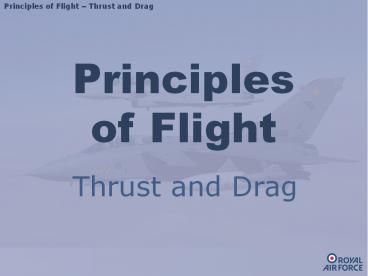Principles of Flight - PowerPoint PPT Presentation
1 / 21
Title:
Principles of Flight
Description:
Principles of Flight Thrust and Drag Principles of Flight So Far You already know that: Every action has an equal and opposite reaction Every object has weight To ... – PowerPoint PPT presentation
Number of Views:241
Avg rating:3.0/5.0
Title: Principles of Flight
1
Principles of Flight
- Thrust and Drag
2
Principles of Flight So Far
- You already know that
- Every action has an equal and opposite reaction
- Every object has weight
- To generate lift, you need airflow over the
wings. - Lift varies with airspeed, angle of attack, wing
shape and air density - For straight and level flight, lift and weight
must be equal
3
Aim of the Lesson
- By the end of the lesson, you should have learnt
- What thrust and drag are, and how they are
produced - How to minimise drag
- How drag varies with the airspeed
- How the levels of thrust and drag affect an
aircrafts flight - What is necessary for an aircraft to be in balance
4
An Aircraft In Flight
- Besides lift and weight, there are two other
forces that act on an aircraft in flight - These are thrust and drag
5
Thrust
- The airflow over the wings that is needed to
generate lift is caused by thrusting the aircraft
forwards through the air. - Thrust is therefore the forward force acting on
an aircraft - It is produced by the engines by throwing air
backwards - Either a propeller can do this, or air can be
expelled from the rear (in the case of a jet
engine)
6
Thrust
- In both cases, throwing air backwards thrusts the
aircraft forces - This is because every action has an equal and
opposite reaction - The size of the thrust depends on the amount of
engine power selected by the pilot
7
Drag
- When youre on a bicycle, the faster you go the
more resistance you encounter - The force which hinders your progress is called
drag - The same can be said for aircraft.
- Every part of the aircraft over which air flows
produces drag which resists forward motion - Thus the more drag there is, the more thrust is
needed to over come it
8
Drag
- However to get more thrust you need a bigger
engine, more fuel and more weight, and therefore
more expense - The aircrafts designer wants to make the
aircraft fly at the best possible speed for the
available thrust - Therefore he will try and reduce drag
- This makes the aircraft more efficient and
economical
9
Causes of Drag
- The shape of the aircraft causes a great deal of
drag - When any object moves through the air it is
accompanied by a wake of complicated eddies and
vortices - In flight, engine power which should be used for
forward power is wasted in making these vortices
10
Drag
- Here is an extreme example a flat plate in an
airflow - The drag is greatest at 90 to the airflow
- The drag is least when it is parallel to the
airflow
11
Minimising Drag
- Drag can be minimised by
streamlining
This means smoothing all the parts of the
aircraft which are in the airflow, thus making
the air flow as smoothly as possible.
It also means minimising the number of protruding
external parts.
12
Minimising Drag
How much drag would this object produce?
A flat circular plate
Answer Maximum Drag
13
Minimising Drag
How much drag would this object produce?
A ball of the same diameter as the plate
Answer 50 Drag (less!)
14
Minimising Drag
How much drag would this object produce?
A streamlined shape (same diameter)
Answer 5 Drag (a lot less!)
15
Minimising Drag
An effective way to streamline shapes is to have
a fineness ratio (length compared to breadth)
of 4(or 3)1
width one unit
length four units
16
Variation of Drag with Airspeed
The amount of drag is proportional to the square
of the airspeed That is, when an aircraft is
going at twice the airspeed there is four times
as much drag.
So, when an aircraft is going at three times the
airspeed, how many times more drag will there be?
Answer 9 times as much drag
17
Thrust and Drag in Straight and Level Flight
You have already learnt that for straight and
level flight, lift must equal weight.
Now we must learn that for the aircraft to travel
at a constant speed, the thrust must be equal to
the drag.
18
Thrust and Drag in Straight and Level Flight
drag
thrust
When thrust drag, the aircraft travels a
constant speed.
When thrust is greater than drag, the aircraft
accelerates.
When drag is greater than thrust, the aircraft
slows down.
19
The Aircraft in Balance
lift
To summarise
thrust
drag
weight
When thrustdrag and liftweight, the aircraft
flies straight and level at a constant speed.
The aircraft is in balance.
20
Questions
21
(No Transcript)































